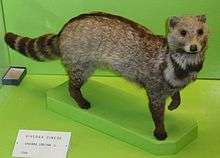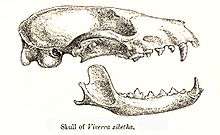Large Indian civet
| Large Indian civet | |
|---|---|
 | |
| Scientific classification | |
| Kingdom: | Animalia |
| Phylum: | Chordata |
| Class: | Mammalia |
| Order: | Carnivora |
| Family: | Viverridae |
| Subfamily: | Viverrinae |
| Genus: | Viverra |
| Species: | V. zibetha |
| Binomial name | |
| Viverra zibetha Linnaeus, 1758 | |
 | |
| Large Indian civet range | |
The large Indian civet (Viverra zibetha) is a civet native to South and Southeast Asia. It is listed as Near Threatened by IUCN since 2008, mainly because of trapping-driven declines in heavily hunted and fragmented areas, notably in China, and the heavy trade as wild meat.[1]
Characteristics

Large Indian civets are generally grizzled greyish brown, with white and black bars along the neck, a white muzzle, and usually two white stripes and three black stripes on the tail. The hair on the back is longer. The claws are retractable, and there is hair in between the paw pads. They are almost as big as a binturong and an African civet, with a head-and-body length ranging from 50 to 95 cm (20 to 37 in) and 38 to 59 cm (15 to 23 in) long tail. The hind foot measures 9 to 14.5 cm (3.5 to 5.7 in). Their weight ranges from 3.4 to 9.2 kg (7.5 to 20.3 lb).[2][3]
Distribution and habitat
The large Indian civet ranges from Nepal, northeast India, Bhutan, Bangladesh to Myanmar, Thailand, the Malay peninsula and Singapore to Cambodia, Laos, Vietnam and China.[1]
Distribution of subspecies
Five subspecies are recognized:[4]
- V. z. zibetha (Linnaeus, 1758) — ranges from Nepal eastwards to Assam;[5]
- V. z. ashtoni (Swinhoe, 1864) — inhabits China;[5]
- V. z. picta (Wroughton, 1915) — ranges from Assam and northern Myanmar to Indochina;[5]
- V. z. pruinosa (Wroughton, 1917) — inhabits Tenasserim and Peninsular Malaysia;[5]
- V. z. hainana (Wang and Xu, 1983)
Six subspecies have been proposed but a taxonomic revision is needed. The validity of the species Viverra tainguensis described in 1997 by Sokolov, Rozhnov and Pham Chong from Tainguen Plateau in Gialai Province in Vietnam has been seriously questioned, and it is now generally considered a synonym of V. zibetha.[1]
Ecology and behaviour
Large Indian civets are solitary and nocturnal. They spend most of their time on the ground, and are agile climbers. During the day, they sleep in burrows that have been dug and abandoned by other animals. They are territorial and mark their territories with excretions from their anal glands. Their territory ranges from 1.7 to 5.4 km2 (0.66 to 2.08 sq mi).
Large Indian civets are mostly carnivorous. They eat birds, frogs, snakes, small mammals, eggs, crabs, and fish, but also fruit and roots.
Reproduction
Females breed at any time of the year, and generally have two litters a year. A litter usually consists of four young. They are born in a hole in the ground or in dense vegetation. They open their eyes at 10 days and are weaned at one month of age.
Conservation

Viverra zibetha is totally protected in Malaysia under the Wildlife Protection Act of 1972 and listed on Category II of the China Wildlife Protection Law. China listed it as ‘Endangered’ under criteria A2acd, and it is a class II protected State species (due to trapping for food and scent glands). It is protected in Thailand, Vietnam and Myanmar. It is found in several protected areas throughout its range. The population of India is listed on CITES Appendix III.[1]
In Hong Kong, it is a protected species under the Wild Animals Protection Ordinance Cap 170, though it has not been recorded in a natural state in Hong Kong since the 1970s, and is considered extirpated.[6]
Local names
In Assamese it is called Gendera or Johamol.
In Hindi language it is called BIJJU
In Bengali it is called Baghdas, Bham or Bham Biral and Gandho Gokul or Khatas. Biral= cat, Gandho= smell or scent. Gokul= the place of Lord Krishna (Govinda). In Bengal there is a delicate variety of sweet and pleasant smelling rice known as Govindabhog rice (the rice which is offered to Lord Govinda). The secretion from prene gland of civet cat smells like that variety of rice, so it is often called as "Gandho Gokul".
In Malay language it is called Musang kasturi (musang = fox, kasturi = musk), due to its musky smell.
In Thai, it is called chamot phaeng hang plong (ชะมดแผงหางปล้อง; pronounced [tɕʰa.mót.pʰɛ̌ːŋ.hǎːŋ.plɔ̂ŋ]; lit. "circular tailed/maned genet")
In Lao, it is called ngen phaeng hang kan (ເຫງັນແຜງຫາງກ່ານ; pronounced [ŋěn.pʰɛ̌ːŋ.hǎːŋ.kāːn]; lit. "stripe-tailed/maned civet")
References
- 1 2 3 4 5 Duckworth, J. W., Wozencraft, C., Wang Yin-xiang, Kanchanasaka, B., Long, B. (2008). "Viverra zibetha". IUCN Red List of Threatened Species. Version 2012.2. International Union for Conservation of Nature.
- ↑ Smith, A. T., Xie, Y. (2008). A guide to the mammals of China. Princeton University Press.
- ↑ Boitani, Luigi, Simon & Schuster's Guide to Mammals. Simon & Schuster/Touchstone Books (1984), ISBN 978-0671428051
- ↑ Wozencraft, W.C. (2005). "Order Carnivora". In Wilson, D.E.; Reeder, D.M. Mammal Species of the World: A Taxonomic and Geographic Reference (3rd ed.). Johns Hopkins University Press. pp. 532–628. ISBN 978-0-8018-8221-0. OCLC 62265494.
- 1 2 3 4 Ellerman, J. R., Morrison-Scott, T. C. S. (1966). Checklist of Palaearctic and Indian mammals 1758 to 1946. Second edition. British Museum of Natural History, London. Page 281.
- ↑ Shek, C. T. (2006). A Field Guide to the Terrestrial Mammals of Hong Kong. Friends of the Country Parks / Cosmos Books, Hong Kong. 403 pp. ISBN 978-988-211-331-2. Page 281
External links
| Wikispecies has information related to: Viverra zibetha |
